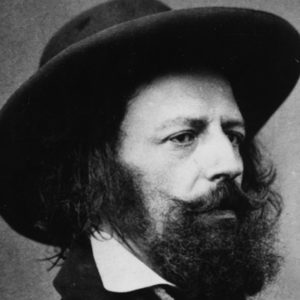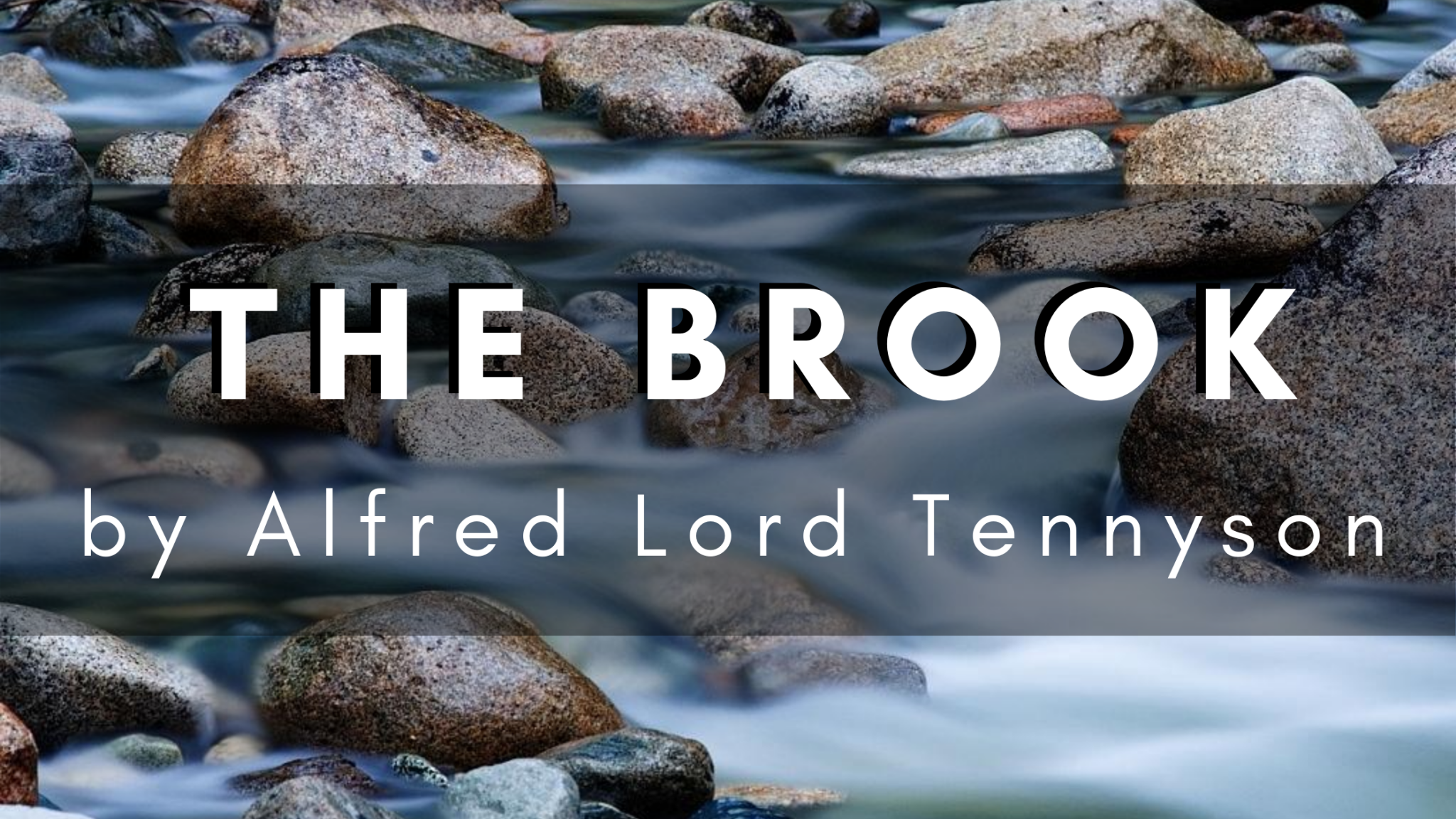The Brook -The Poem
I come from haunts of coot and hern,
I make a sudden sally
And sparkle out among the fern,
To bicker down a valley.
By thirty hills I hurry down,
Or slip between the ridges,
By twenty thorpes, a little town,
And half a hundred bridges.
Till last by Philip’s farm I flow
To join the brimming river,
For men may come and men may go,
But I go on for ever.
I chatter over stony ways,
In little sharps and trebles,
I bubble into eddying bays,
I babble on the pebbles.
With many a curve my banks I fret
By many a field and fallow,
And many a fairy foreland set
With willow-weed and mallow.
I chatter, chatter, as I flow
To join the brimming river,
For men may come and men may go,
But I go on for ever.
I wind about, and in and out,
With here a blossom sailing,
And here and there a lusty trout,
And here and there a grayling,
And here and there a foamy flake
Upon me, as I travel
With many a silvery waterbreak
Above the golden gravel,
And draw them all along, and flow
To join the brimming river
For men may come and men may go,
But I go on for ever.
I steal by lawns and grassy plots,
I slide by hazel covers;
I move the sweet forget-me-nots
That grow for happy lovers.
I slip, I slide, I gloom, I glance,
Among my skimming swallows;
I make the netted sunbeam dance
Against my sandy shallows.
I murmur under moon and stars
In brambly wildernesses;
I linger by my shingly bars;
I loiter round my cresses;
And out again I curve and flow
To join the brimming river,
For men may come and men may go,
But I go on for ever.
~ by Alfred Lord Tennyson
My Friend Suraj K – A short Story
My friend, Suraj K, lives at around an hour’s drive from my home. A little older than me but has been an exceptionally good friend since my childhood. He has a little problem. He can’t stand Delhi’s summers. The summers seem to drain away everything he has.
You can call this state of his summer sickness. The worst part is that none of his friends visit him when he is usually sick. But once the monsoons arrive, and he is recharged with the best of his health, everyone joins his merry celebrations. He also usually hosts a grand party for everyone during winters.
Once, at school, I read this poem, “the Brook”. I knew I had to read this to my friend. The next weekend I visited him and read the same to him. To my surprise, he already knew the Brook. He said she is her cousin from the UK. They have never really met though, but he knows her well. The one thing he really appreciates and adores about his older cousin is that how she manages to stay so cheery all the time.
I really wish my friend Suraj Kund could also be like his cousin. Always cheery, full of life, and be surrounded by happy faces all the time.
Alfred Lord Tennyson

Alfred Tennyson, 1st Baron Tennyson (6 August 1809 – 6 October 1892) was a British poet. He was the Poet Laureate during much of Queen Victoria’s reign and remains one of the most popular British poets. In 1829, Tennyson was awarded the Chancellor’s Gold Medal at Cambridge for one of his first pieces, “Timbuktu”. He published his first solo collection of poems, Poems Chiefly Lyrical in 1830. “Claribel” and “Mariana”, which remain some of Tennyson’s most celebrated poems, were included in this volume. Although decried by some critics as overly sentimental, his verse soon proved popular and brought Tennyson to the attention of well-known writers of the day, including Samuel Taylor Coleridge. Tennyson’s early poetry, with its medievalism and powerful visual imagery, was a major influence on the Pre-Raphaelite Brotherhood.
Tennyson also excelled at penning short lyrics, such as “Break, Break, Break”, “The Charge of the Light Brigade”, “Tears, Idle Tears”, and “Crossing the Bar”. Much of his verse was based on classical mythological themes, such as “Ulysses”, although “In Memoriam A.H.H.” was written to commemorate his friend Arthur Hallam, a fellow poet and student at Trinity College, Cambridge, after he died of a stroke at the age of 22. Tennyson also wrote some notable blank verse including Idylls of the King, “Ulysses”, and “Tithonus”. During his career, Tennyson attempted drama, but his plays enjoyed little success.
A number of phrases from Tennyson’s work have become commonplaces of the English language, including “Nature, red in tooth and claw” (In Memoriam A.H.H.), “‘Tis better to have loved and lost / Than never to have loved at all”, “Theirs not to reason why, / Theirs but to do and die”, “My strength is as the strength of ten, / Because my heart is pure”, “To strive, to seek, to find, and not to yield”, “Knowledge comes, but Wisdom lingers”, and “The old order changeth, yielding place to new”. He is the ninth most frequently quoted writer in The Oxford Dictionary of Quotations.
To read more about Alfred Lord Tennyson, click here.
The Brook – Poem Analysis/Summary
‘The Brook’ is a light and cheerful poem, that can make any reader happy at any point in time. Alfred Lord Tennyson has beautifully described the emotions of a stream who walks with her dancing moves to finally join the river.
This stream joins the river, its final destiny. And The Brooks (as personified by Alfred Lord Tennyson ) mocks the humans as ordinary mortals who get consumed by time.
Sir Tennyson’s love for nature is evident from the fact that how beautifully he adds sensuality in the description of a river.
The poem describes the long and winding journey of a stream towards joining a large river. The poem is set up against the backdrop of the beautiful British countryside. The very elements of which enfolds as the poem progresses. The poem describes the beautiful valleys, the vegetation, the farms, the stones and pebbles, the blossoming fields, the hazel covered lawns, the sun, the moon and stars, everything that she comes across during her journey. Her journey is a never-ending process unlike the mortal humans, who she meets on her way. The whole backdrop and imagery created by Alfred Lord Tennyson look like a fairyland.
The poem was written in 1886, the time when the industrial revolution had just picked up. And it started to have a troll on the environment. But like they say, the beauty is always safely preserved in the work of a writer.
The Form, Structure, & Meter
The general structure of ‘The Brook’ is that of a ballad. And there are 13 paragraphs in the poem each with 4 lines. Some lines are also repeated in the poem. So, the stanzas of the poem are comprised of quatrains and feature a refrain, that is
“For men may come and men may go,
But I go on for ever.”
The poem’s structure consists of 52 lines that are grouped into stanzas of 4 lines. The whole poem is divided into four quarters by the refrain, therefore matches the pattern of a year (52 weeks, grouped into months of roughly 4 weeks, and all quartered into the 4 seasons).
The poem follows a rhyming scheme of ABAB across all its 13 paragraphs.
To read more famous poems by the finest writers ever, click here.









Thank you for sharing this poem. I’ve read it a long time ago till this very day. I enjiyed it very much. 🙂
The best poem!
And what a story you have written, so creative, loved it.
Proud to be a part of this community:)